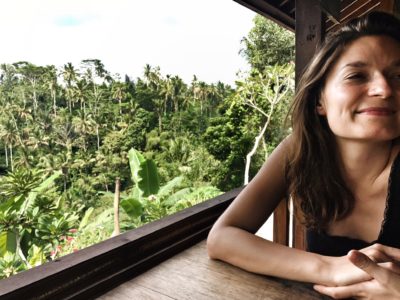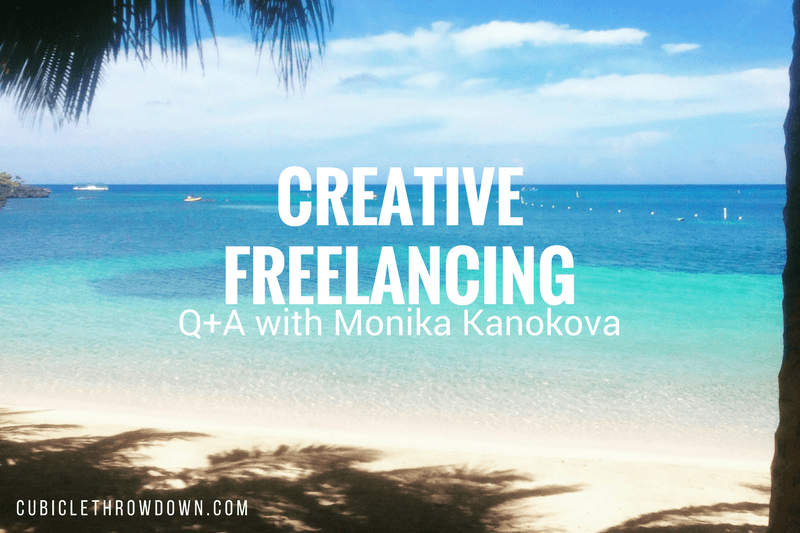One of my goals during my time here in Japan is to start slowly transitioning to a creative freelancing lifestyle. When I leave here, I want to be able to work as a fully location independent freelancer! Over the last six years living abroad, I’ve discovered that I’m not happy having to go to work at the same place every day and doing the same thing. I don’t enjoy the feeling of being “tied down” to a city or an apartment that I might not love in a year or two. I’m all about doing what makes you happy, and now I know what I like and I don’t – so I’m trying to set myself up in a position where I can make that happen.
Through my research, I stumbled upon the stellar Monika Kanokova, author of several guides for creative freelancers to thrive and succeed in their industry. I learned so much through chatting with her about her business and her books that she’s written (including a brand new one!), so I want to share our discussion with you. Thanks so much for all your wisdom about creative freelancing, Monika!
Creative Freelancing Q+A with Monika Kanokova
What does it mean to be a “creative freelancer”, and who falls into that category?
It feels like a trick question, given all my books are for creative freelancers. However, I never define who a creative freelancer is. I believe if someone associates with the word ‘creative,’ has the desire to self-initiate projects, and has the ambition to also monetize them, then they’ll most likely enjoy my guides for #SMARTCREATIVES. Depending on where they are with their career, they might feel most drawn to the first, the second, or now the third book, Work Trips and Road Trips.
How did you start on your path to becoming location independent?
I was in a long distance relationship and didn’t see myself committing to one location. I just couldn’t make the promise I’d want to show up in an office Monday till Friday, week after week.
Once my relationship fell apart, I took on a project that kept me on the road. I had the chance to travel all over the German-speaking market and the Netherlands, helping creatives raise funds for projects.
Generally speaking, I believe it’s about thinking how you can add value. You can say I want to do this and that. But you can also look at it from the other perspective and think what a potential client needs that you can deliver. Kickstarter most certainly found it valuable to have someone in Europe to help them spread the word who also knew how to run a Kickstarter project. It helped that I’m an easy going traveler who doesn’t need much and has friends all over Europe I was able to stay with. It was a win-win; I got to see my friends and I was simultaneously easy on the budget.
If you think about what you can and want to do that’s simultaneously valuable to someone else, you’ll be able to figure out a way to go location independent quickly.
Please tell me about your latest projects.
I am currently finalising a third guide for creative freelancers (there you have the buzzword again), which will be published in mid-June. I called the book Work Trips and Road Trips: An insightful guide for the curious, the restless, and the adventurous freelancer.
I chose the title not just because I put a strong focus on travel, but also because I included a series of articles to illustrate the parallels between working as a freelancer and being on a journey.
I am quite nervous about publishing it because it’s so not the sort of book you look for. I believe it’s much more the sort of book that needs to fall into your hands at the right time. It’s truly hard to pitch, but I believe it might be my best work yet.
What have you learned from all your interviews and discussions you had while putting together your guides?
I’ve just returned from a month long vacation. I quit Facebook for the month, I deleted emails from my phone, and now that I’m back, I’m much more aware of how I approach tasks.
To me and based on what I’ve learned about myself, it’s about going from a reactive mindset to a proactive one. I’ve started drafting a planner as a result of what I’ve learned from re-reading Work Trips and Road Trips six times during the editing process. I’m expecting to go live with the planner on Kickstarter in September, so if you’d like to stay in the loop, you can sign up here.
Who are your guides aimed at?
This Year Will Be Different is for freelancers who are just starting out. It’s for people who’d like some inspiration on how others have gotten started. It’s for people who’d like to get a realistic idea of how long it takes to make enough money to be able to live off of it.
My Creative (Side) Business has two target groups. My initial question was what one could do during a slow month to supplement for the lost income. I wanted to know more about royalty-based businesses. Throughout the process of writing, I realised that many of the women I interviewed started their businesses as hobbies. At some point, they were making more money with their side projects than their day jobs. In a nutshell, the book is for freelancers who’d like to have more stability. And it’s also for people who’d love to become self-employed, but fear they might not make it.
The third book is for more experienced freelancers. The idea for Work Trips and Road Trips came from my inner desire to slow down. Since taking on Kickstarter as a client, life has been wonderful, but simultaneously also fast-paced. I started feeling tired, so I began to explore the topic of travel.
Once I conducted and edited all of the interviews, I realised it wasn’t travel I needed to talk about. There are enough blogs that do just that and are probably better at it. I decided to split the book into five parts. I explored the topics of success, mindfulness, purpose, money, and eventually, travel. I’d say Work Trips and Road Trips is perfect for everyone who’s been freelancing for a while and sometimes wonder what’s next. It’s for people with itchy feet; whether those feet want to explore foreign countries, or just find more time to do yoga, go to the pool, or walk in a forest with their dog.
What’s the top piece of advice you’d give to someone wanting to start out as a creative freelancer while being location independent?
From what I’ve drawn by reading the interviews, I’d say you should pick a realistic date in 6 to 8 months, book a ticket to your first destination, audit your day-to-day expenses, and start saving up now so that you have a deadline. Then, start consciously thinking about packages you want to offer where your location doesn’t play a role. Move all your comms to predefined Skype calls or emails and try to cut out meetings to see whether it’s working out for you.
What benefits can a creative freelancer see from working on the road vs. a traditional office environment?
Many said they spend much less money because they no longer have the desire to treat themselves. Once your environment is new every day, the lust to distract yourself with consumerism usually evaporates.
 When you ask Monika Kanokova what she believes was the greatest gift given to her generation, she’ll reply the social web. In school, she studied interior architecture but once she graduated, she decided to focus on building virtual rooms – just like she’d otherwise build physical spaces. Monika helps her clients connect to their customers through the right messaging and visual storytelling. If you’d like to know more about her work, check out http://mkanokova.com or find Monika on Instagram: http://instagram.com/kathmo
When you ask Monika Kanokova what she believes was the greatest gift given to her generation, she’ll reply the social web. In school, she studied interior architecture but once she graduated, she decided to focus on building virtual rooms – just like she’d otherwise build physical spaces. Monika helps her clients connect to their customers through the right messaging and visual storytelling. If you’d like to know more about her work, check out http://mkanokova.com or find Monika on Instagram: http://instagram.com/kathmo
Want more Cubicle Throwdown in your life? Of course you do, you rockstar. You can follow me on Facebook, Twitter, Instagram, G+ and Pinterest, if you like. You can also add me to your Bloglovin’ feed, or email me! If social media is not your jam and you just want my posts straight to your inbox, check out the sidebar and put your email address in the “Never Miss A Post” box. No newsletters or spam, just my posts – scouts honor. xo!

Amazing freelancer tips, Good inspiration towards creative freelancer.